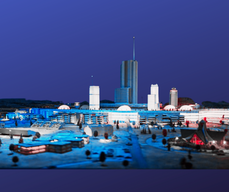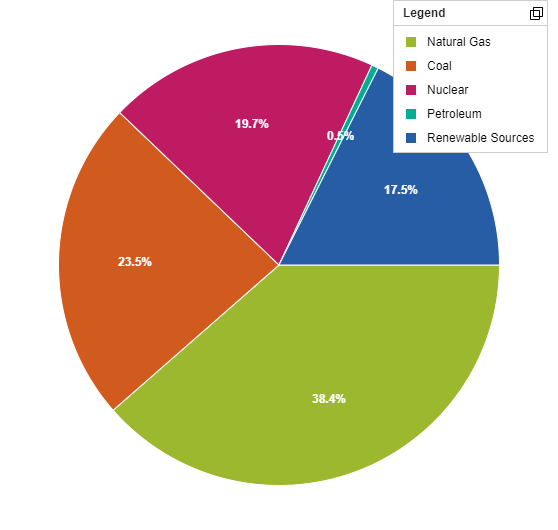Power
 Disneyland tourism image
Disneyland tourism image
From The General Electric Carousel of Progress at Disneyland, and then Disneyworld
There’s a great big beautiful tomorrow
Shining at the end of every day.
There’s a great big beautiful tomorrow,
And tomorrow is just a dream away.
Man has a dream, and that’s the start.
He follows his dream with mind and heart.
And when it becomes a reality,
It’s a dream come true for you and me.
Fondly remembering this attraction, and the promise of a bright future highlighted by the city of the future under glass as you leave to re-enter the park. Yes, there were flying cars and public transportation, light and spires reaching into the sky.
Lets start with a good overview of history and how things are supposed to work, and a definition of Distributed vs. Centralized power production: The U.S. grid has not had substantial investment since it went live. Sure, powerplants are built and repairs happen, but that actual transmission is essentially the same. Power is generated at central plants and distributed via a transmission network through 10 reliability districts throughout the country. Lets be honest, investment reduces quarterly profits for IOU's, yes that is the acronym for an Investor Owned Utility, somewhat ironic. There are approximately 3,200 utilities operating in the U.S., roughly 200 of them are IOUs. These IOUs provide power to approximately 70 percent of all power consumers. An argument can be made that the hurdles to renewable energy lie in the investment required to shift production and delivery models, and the associated drop in revenue. The IOU's, the 800 pound gorillas, is the issue.
U.S. Energy Production by Resource Used
Source: U.S. Energy Information Administration 2019
ELECTRICITY
Energy infrastructure in the U.S. is used to generate, transmit, and distribute electricity. The electric industry has invested significantly to meet customers’ demands, but transmission and distribution (T&D) systems still struggle with reliability. This problem is likely to accelerate as the impacts of climate change persist and the public’s expectation of more reliable, “always-on” electricity increases.
Electricity delivery in the U.S. depends on an aging and complex patchwork of power generation facilities, 600,000 miles of backbone transmission lines (240,000 miles of which are considered high-voltage lines or ≥ 230 Kilovolts), and around 5.5 million miles of local distribution lines that operate within federal, state, tribal, and local regulatory jurisdictions. This system is responsible for providing safe, reliable, and cost-effective electricity to customers. Each type of infrastructure may be owned by an investor or public utility, independent power producer, or governmental agency. While investor-owned utilities (IOUs) make up only 6% of the number of electricity providers, they serve 72% of U.S. electricity customers.
The majority of the nation’s grid is aging, with some components over a century old — far past their 50-year life expectancy — and others, including 70% of T&D lines, are well into the second half of their lifespans. The transmission system, which can be thought of as the “interstate highway” of electricity delivery, is regulated by the Federal Energy Regulatory Commission (FERC), and mostly consists of high voltage transmission lines that carry electricity across the country. The distribution system, the “last mile” of the electric delivery system, is regulated by the states and consists of lower voltage lines that act as the local roadways, carrying electric power to neighborhoods and communities. The distribution system also includes substations, individual customer services and meters, as well as other components. Distribution is a key failure point in the electric grid in terms of system reliability. The distribution system accounts for 92% of all electric service interruptions, a result of aging infrastructure, severe weather events, and vandalism.
These costly transmission and distribution problems, such as those from weather-related events and other causes, result in power outages that are estimated to cost U.S. households $28 to $169 annually. For an increasingly critical sector, U.S. data centers, on which many industries rely, the cost of outages grew from $505,000 in 2010 to $740,000 in 2016, which equates to $8,851 per minute that the electricity grid is malfunctioning.
Source: ASCE Report Card on Electrical Infrastructure
Energy infrastructure in the U.S. is used to generate, transmit, and distribute electricity. The electric industry has invested significantly to meet customers’ demands, but transmission and distribution (T&D) systems still struggle with reliability. This problem is likely to accelerate as the impacts of climate change persist and the public’s expectation of more reliable, “always-on” electricity increases.
Electricity delivery in the U.S. depends on an aging and complex patchwork of power generation facilities, 600,000 miles of backbone transmission lines (240,000 miles of which are considered high-voltage lines or ≥ 230 Kilovolts), and around 5.5 million miles of local distribution lines that operate within federal, state, tribal, and local regulatory jurisdictions. This system is responsible for providing safe, reliable, and cost-effective electricity to customers. Each type of infrastructure may be owned by an investor or public utility, independent power producer, or governmental agency. While investor-owned utilities (IOUs) make up only 6% of the number of electricity providers, they serve 72% of U.S. electricity customers.
The majority of the nation’s grid is aging, with some components over a century old — far past their 50-year life expectancy — and others, including 70% of T&D lines, are well into the second half of their lifespans. The transmission system, which can be thought of as the “interstate highway” of electricity delivery, is regulated by the Federal Energy Regulatory Commission (FERC), and mostly consists of high voltage transmission lines that carry electricity across the country. The distribution system, the “last mile” of the electric delivery system, is regulated by the states and consists of lower voltage lines that act as the local roadways, carrying electric power to neighborhoods and communities. The distribution system also includes substations, individual customer services and meters, as well as other components. Distribution is a key failure point in the electric grid in terms of system reliability. The distribution system accounts for 92% of all electric service interruptions, a result of aging infrastructure, severe weather events, and vandalism.
These costly transmission and distribution problems, such as those from weather-related events and other causes, result in power outages that are estimated to cost U.S. households $28 to $169 annually. For an increasingly critical sector, U.S. data centers, on which many industries rely, the cost of outages grew from $505,000 in 2010 to $740,000 in 2016, which equates to $8,851 per minute that the electricity grid is malfunctioning.
Source: ASCE Report Card on Electrical Infrastructure
Clean Energy, or not
Traditional power, from resource use and production, through transmission and delivery, is horribly toxic. Are renewables, natural gas and nuclear any better?
All approaches have problems, all use resources to manufacture, all are manufactured for cost efficiency and pricing, and not longevity. Here are some things to be aware of:
Traditional power, from resource use and production, through transmission and delivery, is horribly toxic. Are renewables, natural gas and nuclear any better?
All approaches have problems, all use resources to manufacture, all are manufactured for cost efficiency and pricing, and not longevity. Here are some things to be aware of:
While very funny, the facts speak volumes about the issues with Nuclear waste!
Centralized Generation?
The entire U.S. energy infrastructure is built on a centralization of energy production model with nationwide delivery via the "grid". The grid was built out by the federal government in the 1960's and has not been significantly addressed or upgraded since power was deregulated and privatized in the 1980's. Since that time the United States has entered the information age with exponentially growing demands for power, add to that the demands of our changing climate and the methods used to generate the vast majority of power and you have a Jenga game with few moves before collapse. If it were not for the economic impact to the privatized "utility" companies, and their lobbyists, we could have started addressing this forty years ago.
In Kitsap County we are at the end of the delivery lines, being a peninsula, coming from the south and east through areas where FEMA has reported that we could lose power for up to a year if a large disaster occurred like the expected Cascadia Rising event. That would severely impact almost 300,000 people, almost 70% of who rely on electric heat. More concerning is the changing climate with hotter summers! Traditionally Washingtonian's have not needed air conditioning due to the mild weather. That is changing, but the power grid is not, if everyone in Kitsap got and turned on their AC it would likely bring down the grid here. Puget Sound Energy and the majority of other privatized utilities are for profit corporations where the bottom line and shareholder profits are the main focus. To change the existing generation and grid model would take major investment that they have not been willing to provide. This leaves it for the Government to do...
The entire U.S. energy infrastructure is built on a centralization of energy production model with nationwide delivery via the "grid". The grid was built out by the federal government in the 1960's and has not been significantly addressed or upgraded since power was deregulated and privatized in the 1980's. Since that time the United States has entered the information age with exponentially growing demands for power, add to that the demands of our changing climate and the methods used to generate the vast majority of power and you have a Jenga game with few moves before collapse. If it were not for the economic impact to the privatized "utility" companies, and their lobbyists, we could have started addressing this forty years ago.
In Kitsap County we are at the end of the delivery lines, being a peninsula, coming from the south and east through areas where FEMA has reported that we could lose power for up to a year if a large disaster occurred like the expected Cascadia Rising event. That would severely impact almost 300,000 people, almost 70% of who rely on electric heat. More concerning is the changing climate with hotter summers! Traditionally Washingtonian's have not needed air conditioning due to the mild weather. That is changing, but the power grid is not, if everyone in Kitsap got and turned on their AC it would likely bring down the grid here. Puget Sound Energy and the majority of other privatized utilities are for profit corporations where the bottom line and shareholder profits are the main focus. To change the existing generation and grid model would take major investment that they have not been willing to provide. This leaves it for the Government to do...
We Need Solutions
Understanding that you are the visionaries and experts we are looking to, there are some things that we have identified as starting points:
Understanding that you are the visionaries and experts we are looking to, there are some things that we have identified as starting points:
- Community Microgrids that have management and storage components and where excess power feeds into the existing grid.
- A shift in priorities from powering the grid, to powering the home, then the community and finally the grid.
- Restructuring of utilities to provide local infrastructure instead of selling power. This only really works with Public Utility Districts (PUD), not IOUs where profit is the motive and not service. Having financed the technology and installation, the utility would charge a flat fee to support the infrastructure. If done properly, this should be affordable and provide greater service security.
- A full review of available technologies and the potential integrations for solar, wind, hydro, geothermal, based on maximizing production, not cost and profit i.e., solar on every roof does not work when cost of the panel is a greater concern that catching all available light for a community.
- The development of a new federal incentive program that allows renewables to be applied across the board in every community.
